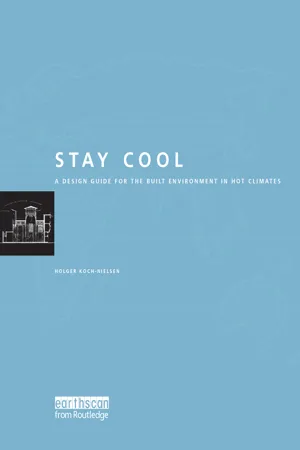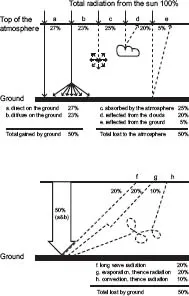![]()
1. Climatic issues
The climate of a given region is generally defined as the interaction of several meteorological elements. The principal elements are:
•solar radiation
•air temperature
•humidity
•wind
•precipitation.
These data should be collected and analysed as the first step in understanding the overall climatic conditions of a particular area. They are normally obtainable and must be analysed on the basis of several years of data in order to establish the design-climatic conditions (design year or period). Site-specific climatic elements, which are normally not readily available, must be observed and analysed together with the regional data.
The following features, which also influence the climate of the specific site, should also be examined:
•topography
•ground cover and vegetation
•water
•building densities.
Generalised climatic zones have been developed to determine common design responses required for the different zones. The characteristics used to define hot dry and warm humid climatic zones are provided at the end of this chapter. This information is the basis for the design responses described throughout this Guide.
METEOROLOGICAL ELEMENTS
Solar radiation
The intensity of solar radiation experienced by an area depends ultimately on the altitude (i.e. the position) of the sun and the quantity of particles in the atmosphere. It will vary greatly depending on the geographical location and local weather conditions.
Essentially solar radiation will be affected by the length of day the angle of the sun's rays to the ground, the distance from the sun, the cloud coverage and the quality of the atmosphere through which the radiation passes.
Radiation is experienced in the form of wavelengths. There are two distinct types of wavelength that will affect the heat gains and losses of a building:
•short-wave radiation; this is also referred to as high-temperature or visible radiation as it is radiation received from the sun or other very high-temperature sources; and
•long-wave radiation, which is also referred to as heat or invisible radiation, as it is the radiation that is emitted from a hot object such as a building surface and absorbed by less hot objects or the atmosphere.
There are three main types of radiation that will affect a building and the amount of heat transferred into a building:
•direct solar radiation, which is the component of radiation received directly from the sun (from the direction of the solar rays);
•diffuse solar radiation, which is the component of radiation that is received from the whole sky vault, i.e. the sky, clouds and atmosphere (from all directions); and
•reflected solar radiation, which is the component of radiation that is reflected from the ground and other objects, e.g. other buildings.
The passage of solar radiation through the atmosphere and its impact on the environment. The distributions of the components in the diagrams are average figures. They will in general vary according to the weather conditions and the time of day. The diagram below shows the radiation heat gains and losses that take place on the ground. Gains normally take place during the day and losses during the night. If the balance between gains and losses is disturbed, the ground temperature will change. The greenhouse effect will for example reduce the radiation losses, which will cause higher average temperatures on the earth's surface.
(top) Shows a classical Stevenson cage for meteorological temperature measurements, (above) A close-up view of the wet bulb (wetted) thermometer and the dry bulb thermometer.
Air temperature
Air temperature is in meteorological terms a measurement taken in the shade approximately 1.5 m above the ground in a ventilated box, in order to prevent radiation from the sun and the ground from affecting readings. Air temperature is normally referred to as the dry-bulb temperature as opposed to the wet-bulb temperature. Both temperatures are measured simultaneously in the same ventilated box using two thermometers. The wet-bulb temperature is measured simply by keeping the thermometer humid in a wet piece of cloth. With the two temperature measurements, the specific humidity and the relative humidity can also be determined. Meteorological air temperature is not the same as the temperature or heat experienced in the built environment by humans, where solar radiation and radiation from the environment affect the experience of temperature.
The degree of heating and cooling of the surface of the earth is the main factor determining the temperature of the air. Generally, temperatures are lowest just before sunrise and are highest two hours after noon, when the effects of direct solar radiation and high air temperatures are combined.
It is important to try to obtain not only the maximum temperature, but also the minimum temperature variation for a region. This will give an indication of the diurnal variations (i.e. the temperature difference between day and night). Since a large diurnal range is indicative of dry weather and clear skies, one can anticipate intense solar radiation by day and strong outgoing radiation by night, whereas a small diurnal range indicates an overcast sky and a high humidity range.
Humidity
This term refers to the water vapour content of the atmosphere gained as a result of evaporation from exposed water surfaces, from moist ground and from plant transpiration. For any given temperature there is a limit to the amount of water that can be held as vapour, and the air's capacity increases progressively with increases in temperature.
Terms used to describe the moisture content in air relevant from a design point of view are as follows.
•Relative humidity is defined as the ratio of the actual humidity in a given volume of air to the maximum moisture capacity at that particular temperature. It is the term most commonly used to describe humidity.
•Vapour pressure is the part of the total atmospheric pressure that is due solely to the water vapour. The term is used in meteorological data and in technical literature.
To illustrate wind characteristics a wind rose is often used. This arbitrary wind rose could represent data collected for a period of a week, a month or a year. For natural ventilation design the wind characteristics distribution during the ‘design hours’ has to be established, data that are not always readily available.
Wind
Direction, speed, gustiness and frequency are the most important characteristics of wind. Wind roses are normally used to indicate the characteristics of wind for a specific period of time, e.g. a day a month or a year. Depending on the origin of a wind its quality will differ. It can be dry or humid, clean or dusty, hot or cool. Wind is a very unstable parameter as characteristics fluctuate according to prevailing weather conditions.
The winds over a region, their distribution and characteristics are affected by both global and local factors. However, the principal determinants are seasonal differences and daily variations. In West Africa in the winter, for example, hot dusty winds are from the north-east, and in the summer humid winds are from the south-west.
The direction, speed and predictable daily and seasonal shifts of prevailing winds must be determined and analysed so that their positive or negative aspects can be used or overcome.
There is a variation in wind speeds ...



